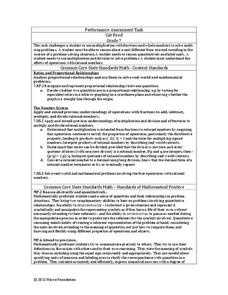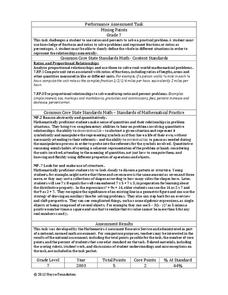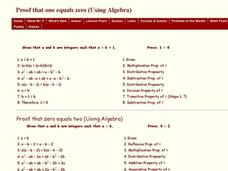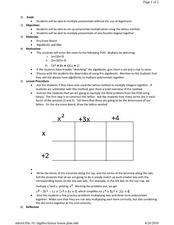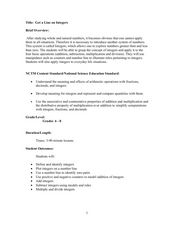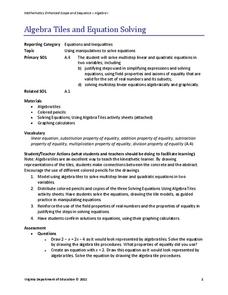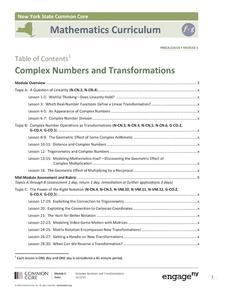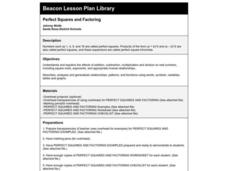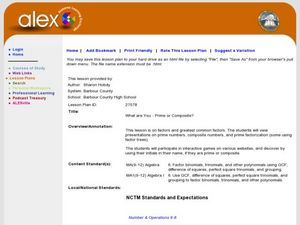Illustrative Mathematics
Seeing is Believing
How many visual models can be used to show multiplication? Three basic kinds of models can be used to represent and explain the equation 4 x (9 + 2). The commentary section provides description and graphics to explain the set...
Curated OER
Pyrotechnics
Learners discuss pyrotechnics and what they have noticed about their height and speed. They think about the path which fireworks follow which is a parabola. They follow multiplication patterns to determine the Zero Product Property and...
Curated OER
Solving Linear Systems Using Matrices
Start with the definition of a determinant and how to evaluate a 2x2 determinant. Apply this skill to solve systems of two equations with two unknowns by using Cramer's rule. These four basic problems would be good for a quick review or...
Curated OER
Working with larger arrays
Fifth graders use arrays to show the meaning of multipication in selected situations. They practice using large and small arrays. The instructional activity has numerous activities, which gives students more opportunities to display...
Noyce Foundation
Cat Food
Determine the right mix of cans of cat food. The resource consists of an assessment task to determine the cost to feed two cats for a specific number of days and requires scholars to interpret remainders within a context....
West Contra Costa Unified School District
Divisibility Rules Justified
How do you know if a number is divisible? Instructors first prove the divisibility rules for three and four and then class members use this modeling to prove given divisibility rules for eight and nine either individually or in...
Curated OER
Students Multiply Polynomials
Factor polynomial functions that have two and three terms. Using Algeblocks, your class will create models to show their understanding of these concepts.
Noyce Foundation
Mixing Paints
Let's paint the town equal parts yellow and violet, or simply brown. Pupils calculate the amount of blue and red paint needed to make six quarts of brown paint. Individuals then explain how they determined the percentage of the brown...
Curated OER
Direct, Inverse, And Joint Variation
Young scholars engage in a lesson that has them practice solving equations using multiplication and division. They practice solving problems using the properties needed and then students practice changing word problems into an equation.
Curated OER
Proof that One Equals Zero and Zero Equals Two
In this algebra worksheet, 11th graders complete proofs that show why properties are true. There are 2 proofs given with 8 required steps.
EngageNY
Why Were Logarithms Developed?
Show your class how people calculated complex math problems in the old days. Scholars take a trip back to the days without calculators in the 15th installment of a 35-part module. They use logarithms to determine products of numbers and...
West Contra Costa Unified School District
Multiplying Binomials and Factoring Trinomials
Two lessons for the price of one! Learners use algebra tiles to multiply binomials in the first lesson, Next, they use their knowledge from the first lesson to factor trinomials into two binomials.
Curated OER
Students Multiply Polynomials without Algeblocks
Introduce your class to the lattice method as a way to multiply polynomials. This lesson plan is specifically aimed at getting students to use methods other than Algeblocks to solve polynomials.
Curated OER
Get a Line on Integers
Students explore number sense by completing math function problems in class. In this integers lesson, students define integers and practice plotting them on a number line. Students utilize math functions such as addition and...
Virginia Department of Education
Algebra Tiles and Solving Equations
Young mathematicians solve linear equations by drawing models of algebra tiles using colored pencils. To finish, they solve the same equations algebraically and check their answers using a graphing calculator.
Curated OER
Two-Step Equations
Sixth graders work through a two-step equation with their teacher. After reviewing one-step equations, they complete a worksheet using tiles and colored pencils to complete two-step equations. To end the lesson, they write out the step...
Curated OER
Complex Numbers
In this complex numbers learning exercise, students simplify 9 problems involving the addition, subtraction, multiplication, and division of complex numbers.
Curated OER
Dragon Math
Third graders, in groups, practice multiplication by putting five multiplication problems on white scales, then the answers on florescent colored scales.
Curated OER
Multiplying in Columns, Standard Way
In this multiplying worksheet, students multiply two digit numbers. Explanations and examples are provided prior to the exercise. This two-page worksheet contains 20 problems.
Curated OER
Multiple Ways to Add and Subtract
Third graders recall multiplication facts to tens. They recall factors of numbers generated by multiplication facts to ten. Students become familiar with the use of brackets in notation. They multiply two digit numbers by a single...
EngageNY
Complex Numbers and Transformations
Your learners combine their knowledge of real and imaginary numbers and matrices in an activity containing thirty lessons, two assessments (mid-module and end module), and their corresponding rubrics. Centered on complex numbers and...
EngageNY
Polynomial, Rational, and Radical Relationships
This assessment pair goes way beyond simple graphing, factoring and solving polynomial equations, really forcing learners to investigate the math ideas behind the calculations. Short and to-the-point questions build on one another,...
Curated OER
Perfect Squares and Factoring
A teacher guided lesson on perfect squares and factoring. They discuss perfect squares, observe the expansion steps for finding the product, and practice solving problems. They complete a worksheet on perfect squares and factoring.
Curated OER
What Are You - Prime or Composite
Students explore the concept of prime factorization. In this prime factorization activity, students participate in an activity where they find the prime factorization and greatest common factor of a number derived from their name....




